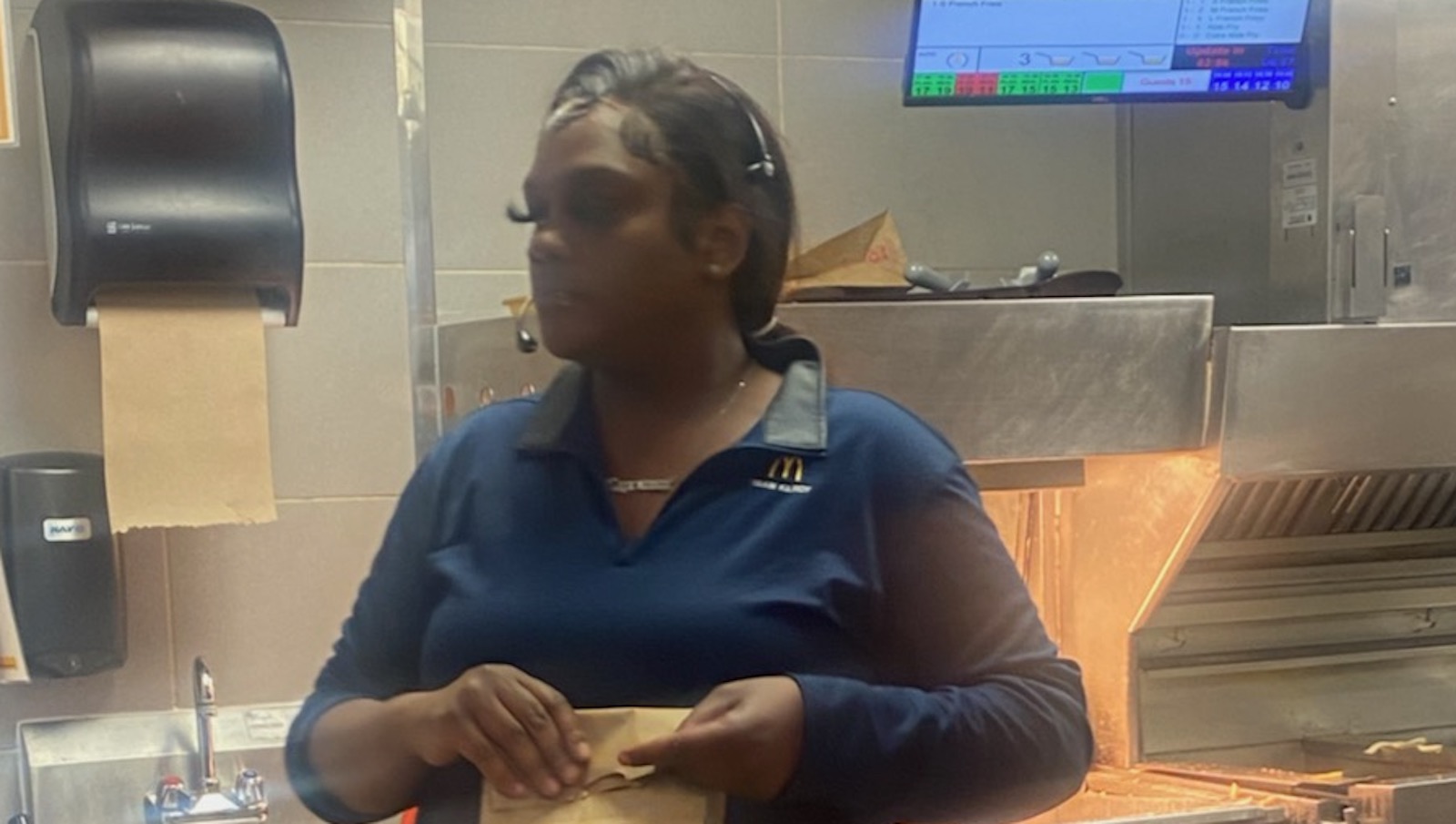Welcome to How Are You Coping With That? a recurring column in which Lori Teresa Yearwood talks to people about how they are coping with hardship.
CINCINNATI, Ohio — On Jan. 20, three weeks after a fast-paced eviction scattered her family and their belongings across town like windswept leaves, Nieshea Walker and her two children moved into an emergency shelter for some of the poorest families in the city.
Now Walker’s 14-year-old daughter is at the child’s grandmother’s house. “She is in a tender place in her life and was embarrassed around her peers about being homeless,” Walker says.
Her two younger children are with Walker at the shelter: 7-year-old Key’arah, a child whose face routinely shifts from bright smiles to the introversion of a little girl contemplating overwhelming, almost unfathomable changes; and 9-year-old Key’marre, a studious looking boy with black-rimmed glasses and a propensity to remind his mom of the daily tasks needed to be accomplished in their new life. “Don’t forget to go to Kroger’s for cereal,” he often says. And: “Mom, we need to keep on schedule.”
Walker, 34, is a full-time, night-shift manager at McDonald’s. She makes $33,000 a year, but could not afford the $100-a-month hike on her last rental, an increase that brought the rent up to $1,200 a month. As a full-time worker, as well as a single mom responsible for three children, Walker still can’t afford the average $1,273 per month market-rate rental apartment in Cincinnati.
After falling two months behind on the rent, Walker was ordered to vacate her apartment by a Hamilton County Judge. Walker was evicted on Dec. 29, but she was still living in the apartment on Jan. 11, when she thought she’d been saved by the county’s rental assistance program. Walker had gotten approval for $6,549 in relief funds, an amount meant to cover two months of back rent, three months of future rent, and various fees related to the eviction process. Walker sent a photo of her approval letter to her apartment’s management company, Blue Vista Realty. She was evicted anyway. Walker later discovered that the county has since paid the $6,549 to Blue Vista by direct deposit. Nobody at the company will answer my questions about what happened to that money.
Walker left her apartment during a month in which there were 1,310 eviction filings in Cincinnati—a 30-percent increase over pre-pandemic averages in the city, according to national Eviction Lab statistics. Walker filled her car with her family’s belongings, finding storage where she could.
The children’s PlayStation is at Walker’s mother’s house. The family’s movie projector and photos, toys, bicycles, giant coloring books, and arts and crafts projects are at Walker’s best friend’s house. Walker’s kitten, Bella, is there, too. Walker’s predicament is one born of the insidious inequalities that haunt the working poor in America.
Consider that Walker’s story includes the inability to find a home she can afford to rent even though she has held the same full-time job for the last four years. Now juxtapose that experience with the fact that there are seven million affordable units for 11 million households for low-wage earners in this country—but of that seven million, 3.3 million are occupied by people with higher incomes, according to research from the Urban Institute’s Housing Matter’s Initiative. Then notice that Walker is a Black, single mother in America, where Black renters are nearly twice as likely to be evicted as their white counterparts, according to Peter Hepburn, an assistant professor at Rutgers University and a research fellow at Princeton’s Eviction Lab.
Of the more than 1.5 million people that the United States Interagency Council on Homelessness estimates are unhoused in the course of a year in this country, approximately 40 percent of those individuals are Black. That’s a hugely disproportionate number, given that Blacks represent only 13 percent of the general population.
Contrary to stereotypes that paint people experiencing homelessness as “lazy bums,” research shows that 53 percent of individuals who find themselves stuck on this particular bottom rung of society work part- or full-time.
“I call what has happened to me ‘The Big Runaround,’” Walker says. “It gives me a lot of anxiety.”
On a recent Tuesday afternoon, I watched her stand beneath the fluorescent lights of her family’s room at the shelter, directing a stream of orders not only to her children, it seemed to me, but far beyond them, toward the chaos that has engulfed her life since she lost her home.
“Get dressed. Hurry up—we have to get out soon,” Walker said. Then, in a softer voice: “That’s not the clean clothes, baby—the clean clothes bags are on the bottom bunk.”
Two double bunk beds line the walls. Key’arah and Key’marre have tossed their clothes on the floor or draped them on the railings of the beds. This is how they know where everything is, Walker explained. The family has moved from room to room inside the shelter three times in the three months they’ve been there. During that time, an infant who lived in a nearby room died, Walker said. The executive director of the shelter said that, due to confidentiality reasons, she could neither confirm or deny the death of the infant. Walker said she often heard the baby screaming at night. In an effort to soothe Key’arah and Key’marre, she did not tell them that. Instead, she told them that everyone leaves this earth at some point, some sooner than others. The children gradually accepted that answer.
“But it’s confusing for them here,” Walker says.
Confusion, it strikes me, appears to be a natural response to the disorienting set of circumstances that helped to create and now sustains Walker’s homelessness. For the past few months she’s been stuck in a bewildering feedback loop of emails and phone calls with people who have only made her situation more precarious and opaque. She showed me some of these emails, and after reading them it’s hard not to feel like she’s being purposely misled by the people who forced her out of her home.
On Dec. 14, 2022, Walker emailed Saravana Bharathi, the Blue Vista employee she dealt with most often. She sent Bharathi a photo of her claims submission to Hamilton County for rental assistance funds, hoping to convince Blue Vista to delay her eviction until the funds were approved.
A Hamilton County judge ruled for Walker’s eviction on Dec. 29, and gave her seven days to move out. On Jan. 11, 2023, Walker got word from the county that her application for rental assistance had been approved, and that she would be granted $6,549 in relief funds. Walker emailed a photo of this approval letter to Bharathi.
Minutes later, Bharathi wrote back, “Thank you. Your eviction will be canceled if we receive the money before set out date.”
Less than two hours later, however, Walker received a follow-up email from Bharathi that said, “The owner doesn’t want to accept the payment & he wants you to leave. They already called the bailiff to set out.”
Walker wrote back, asking for the set-out date. Bharathi wrote back a few minutes later, telling Walker to “call the bailiff to find out.” Walker followed up again, asking why Bharathi couldn’t just tell her when the set-out date was. A few more minutes passed before Bharathi wrote back to tell Walker, “We don’t manage this building anymore.” Bharathi then instructed her to get in touch with someone at a different management company called Paradigm Property.
Walker wrote that person an email, marking it “urgent” and asking the person in charge of the property to call her. She did not receive a response, she says. “I knew I had gotten the run-around,” Walker told me later.
Fran Quigley, clinical professor and director of the Health and Human Rights Clinic at the Indiana University McKinney School of Law, says that what happened to Ms. Walker is “far too common.”
“Our clients often struggle to reach anyone who admits to having the ability or authority to respond to urgent maintenance issues, accept rent, provide accurate information about rent and costs owed, etc,” Quigley says. “That confusion caused by the landlords often drives tenants into eviction court and then to lose their homes.”
Exacerbating the powerlessness between tenant and landlord is the imbalance of legal representation, or lack thereof. Most landlords have the money to hire an attorney; most low-wage earners don’t. One meta-analysis study stated that parties represented by lawyers are between 40 percent and 1,380 percent more likely to receive favorable outcomes in adjudication than are parties representing themselves.
On April 14, I contacted Blue Vista. They told me what they told Walker: that Blue Vista no longer managed the property. I then wrote to the same email address at Paradigm Property that Bharathi had told Walker to use. Tami Hulgin, a woman in accounts receivable for Paradigm Property Management, wrote back: “Blue Vista Realty LLC filed the eviction. We took over management of the property after and only managed it for less than a month … Blue Vista Realty LLC is who you should be speaking with.”
I asked Hulgin if she could tell me who was currently managing the property. She responded, “I am sorry I do not know who manages the property now. We started managing on January 1st and didn't even manage the full month.”
These answers made me feel like I was freefalling through the sky without a parachute. And I was merely the journalist writing the story, not the people living it.
On April 17, I made a public records request to Hamilton County Job and Family Services, asking what happened to the $6,549. Four days later, Walker also made an in-person visit to the county. That afternoon, Walker received an email from the county, which she showed me, stating that the $6,549 payment had been made to Blue Vista Realty via direct deposit on Feb. 9. On April 26, Hamilton County responded to my records request, writing, “HCJFS sent payment via a direct deposit to Blue Vista Realty on February 9, 2023. This payment included the $6,549.00.”
I wrote to Blue Vista asking for clarification. Bharathi responded: “We didn’t execute the writ, I don’t know who did. Also we didn’t manage the property at the time this tenant leaving the place.”
I have since sent two additional requests for comment to Bharathi, asking if they can explain what happened to the $6,549, or if they have any comment to make at all. I have not received a response.
“It’s been a mind-boggling experience,” Walker tells me. “It’s like your government is helping you pay your rent and someone just stole that money from you. And I’m so caught up in just making sure I have somewhere to lay my head.”
In the two weeks that Walker spent waiting for a room at the shelter, she lived alone in a hotel room for $140 a night—money she borrowed from a friend—frantically trying to secure space at a shelter for herself and her family. Finally, a woman working a helpline told Walker to call back the next day and for Walker to tell whoever answered the phone that she was living in her car, not a hotel. The likely reason: the U.S. Department of Housing and Urban Development (HUD) defines homelessness as living in an inhabitable place for humans and does not include hotel living in that definition. Walker did as she was told—and she and her family were given shelter the next day, she says.
When she and her family moved into the shelter, Walker was, as are new residents in shelters across dozens of states in this country, asked to answer a series of questions that constitute the Vulnerability Index – Service Prioritization Decision Assistance Tool (VI-SPDAT). The tool generates a score that results in clients being prioritized for permanent supportive housing, rapid rehousing, or transitional housing options, and is approved by HUD. The VI-SPDAT is rife with controversy.
A 2019 study discovered, for instance, that the assessment did not “equitably capture vulnerabilities,” and that people of color received lower scores than whites.
“They asked me all kinds of personal questions, such as whether I had been sexually abused,” Walker says. “But at the end of the day, I don’t feel like I should be judged about whether I have a disability or mental instability. My main issue is that I have an eviction on my record.”
In the three months that Walker has been at the shelter, she has watched many people move into homes of their own, and it frustrates her, she tells me.
“I know that once I get stable housing I can stabilize myself,” Walker says.
Barbara Duffield, executive director of Schoolhouse Connection, a national nonprofit that works to help children overcome homelessness through education, says that one of the least understood aspects about homelessness is how racism creates barriers to seeking and receiving help.
“For example, Black parents may be reluctant to disclose their situation to either a helpline or a school professional—or others who may be in a position to help—because of a lack of trust, and fear that their child may be taken away from them and put into child welfare,” Duffield says. “And we know that Black children are removed from homes at twice the rate of white children.” There is almost no aspect beyond housing for moms that doesn’t have a strong racial dynamic, Duffield added.
“And that is borne out in the Vulnerability Index that HUD requires," Duffield says. "The questions put Black women at a disadvantage because they are less likely to report certain behaviors or experiences than white women. And there is trauma that is involved in answering these questions, which compounds the barriers.”
Far away from any statistics, waiting inside her car at her children’s school, the effect of homelessness on the lives of her children weighs heavily on Walker. One of Key’arah’s teachers recently called for a parent-teacher meeting because Key’arah was repeatedly vomiting in class. At first, Walker took the symptom at face value, bringing her child back to the shelter to spend time with her. But when the vomiting continued, Walker pulled her daughter aside.
“I told her, ‘If it’s just the time you want to spend with me, I’m sorry. I’m here for you and we’re going to make the best of it.’ It turned out she was putting her finger down her throat so she could spend more time with me. But after that, I haven’t had any more problems with her throwing up.”
As for herself, Walker says, she is mostly exhausted. Her co-worker, Taniya Jackson, also a night-shift manager at McDonald’s, says she often sees her friend struggling emotionally. “She’s a good person. But she’s everywhere. She needs to be in one spot. So she’s aggravated—angry.”
Sometimes, she comes into work with a strident attitude, Jackson says. That’s when Jackson tells her: “Come back to work. You gotta leave that stuff outside. When you walk in that door, it’s another problem you got to deal with.”
To help Key’arah and Key’marre feel as safe and loved as possible, Walker tries to emulate the conditions of “home,” she says. For example, since Key’marre is lactose intolerant and can’t always eat the shelter food, Walker takes him and his sister out for foods they used to eat at home. And she takes them to the park to play outside like they did in their own backyard.
Right now, Walker has $600 saved for the future. She had $1,000, she says, but her car note, which she had fallen behind on during the eviction, was repossessed and she had to pay to get it back, as well catch up on payments. Since then, the cost of non-shelter food and a night time babysitter—Walker picks Key’arah and Key’marre up at the babysitter every night after her shift has ended—has kept Walker from adding to her savings.
But, Walker says, she is staying strong. On school mornings, just before the children head out of Walker’s car and into school, Walker tells them: “Our situation does not define us. We’re going to make it out of this.”
This story was supported by The Economic Hardship Reporting Project.





